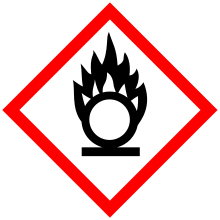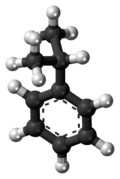Cumene
Cumene (isopropylbenzene) is an organic compound that is based on an aromatic hydrocarbon with an aliphatic substitution. It is a constituent of crude oil and refined fuels. It is a flammable colorless liquid that has a boiling point of 152 °C. Nearly all the cumene that is produced as a pure compound on an industrial scale is converted to cumene hydroperoxide, which is an intermediate in the synthesis of other industrially important chemicals, primarily phenol and acetone.
| |||
| Names | |||
|---|---|---|---|
| Preferred IUPAC name
(Propan-2-yl)benzene[1] | |||
Other names
| |||
| Identifiers | |||
3D model (JSmol) |
|||
| 1236613 | |||
| ChEBI | |||
| ChEMBL | |||
| ChemSpider | |||
| ECHA InfoCard | 100.002.458 | ||
| EC Number |
| ||
| KEGG | |||
PubChem CID |
|||
| RTECS number |
| ||
| UNII | |||
| UN number | 1918 | ||
CompTox Dashboard (EPA) |
|||
| |||
| |||
| Properties | |||
| C9H12 | |||
| Molar mass | 120.195 g·mol−1 | ||
| Appearance | colorless liquid | ||
| Odor | sharp, gasoline-like | ||
| Density | 0.862 g cm−3, liquid | ||
| Melting point | −96 °C (−141 °F; 177 K) | ||
| Boiling point | 152 °C (306 °F; 425 K) | ||
| negligible | |||
| Solubility | soluble in acetone, ether, ethanol | ||
| Vapor pressure | 8 mm (20°C)[2] | ||
| -89.53·10−6 cm3/mol | |||
Refractive index (nD) |
1.4915 (20 °C) | ||
| Viscosity | 0.777 cP (21 °C) | ||
| Hazards | |||
| Main hazards | flammable | ||
| GHS pictograms |     | ||
| GHS Signal word | Warning | ||
GHS hazard statements |
H226, H302, H304, H312, H314, H332, H335, H341, H412, H441 | ||
| P201, P202, P260, P261, P264, P270, P271, P273, P280, P281, P301+312, P301+330+331, P302+352, P303+361+353, P304+312, P304+340, P305+351+338, P308+313, P310, P312, P321, P322, P330, P363, P405 | |||
| NFPA 704 (fire diamond) | |||
| Flash point | 43 °C (109 °F; 316 K) | ||
| 424 °C (795 °F; 697 K) | |||
| Explosive limits | 0.9-6.5% | ||
| Lethal dose or concentration (LD, LC): | |||
LD50 (median dose) |
12750 mg/kg (oral, mouse) 1400 mg/kg (oral, rat)[3] | ||
LC50 (median concentration) |
200 ppm (mouse, 7 hr)[3] | ||
LCLo (lowest published) |
8000 ppm (rat, 4 hr)[3] | ||
| NIOSH (US health exposure limits): | |||
PEL (Permissible) |
TWA 50 ppm (245 mg/m3) [skin][2] | ||
REL (Recommended) |
TWA 50 ppm (245 mg/m3) [skin][2] | ||
IDLH (Immediate danger) |
900 ppm[2] | ||
| Related compounds | |||
Related compounds |
ethylbenzene toluene benzene | ||
Except where otherwise noted, data are given for materials in their standard state (at 25 °C [77 °F], 100 kPa). | |||
| Infobox references | |||
Production
Commercial production of cumene is by Friedel–Crafts alkylation of benzene with propylene. Cumene producers account for approximately 20% of the global demand for benzene.[4] The original route for manufacturing of cumene was by alkylation of benzene in the liquid phase using sulfuric acid as a catalyst, but because of the complicated neutralization and recycling steps required, together with corrosion problems, this process has been largely replaced. As an alternative, solid phosphoric acid (SPA) supported on alumina was used as the catalyst.
.svg.png)
Since the mid-1990s, commercial production has switched to zeolite-based catalysts.[5] In this process, the efficiency of cumene production is generally 70-75%. The remaining components are primarily polyisopropyl benzenes. In 1976, an improved cumene process that uses aluminum chloride as a catalyst was developed. The overall conversion of cumene for this process can be as high as 90%.
The addition of two equivalents of propylene gives diisopropylbenzene (DIPB). Using transalkylation, DIPB is comproportionated with benzene.[6]
Safety
Cumene forms peroxides upon long exposure to air.[7] Tests for peroxides are routinely conducted before heating or distilling.
References
- Nomenclature of Organic Chemistry : IUPAC Recommendations and Preferred Names 2013 (Blue Book). Cambridge: The Royal Society of Chemistry. 2014. pp. 139, 597. doi:10.1039/9781849733069-FP001. ISBN 978-0-85404-182-4.
- NIOSH Pocket Guide to Chemical Hazards. "#0159". National Institute for Occupational Safety and Health (NIOSH).
- "Cumene". Immediately Dangerous to Life and Health Concentrations (IDLH). National Institute for Occupational Safety and Health (NIOSH).
- Market Study Benzene, published by Ceresana, July 2011
- The Innovation Group website, page accessed 15/11/07
- Bipin V. Vora, Joseph A. Kocal, Paul T. Barger, Robert J. Schmidt, James A. Johnson (2003). "Alkylation". Kirk-Othmer Encyclopedia of Chemical Technology. Kirk‐Othmer Encyclopedia of Chemical Technology. doi:10.1002/0471238961.0112112508011313.a01.pub2. ISBN 0471238961.CS1 maint: uses authors parameter (link)
- CDC - NIOSH Pocket Guide to Chemical Hazards


